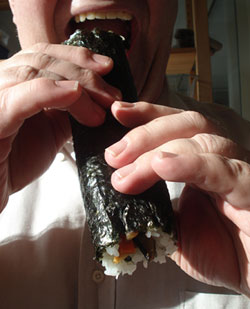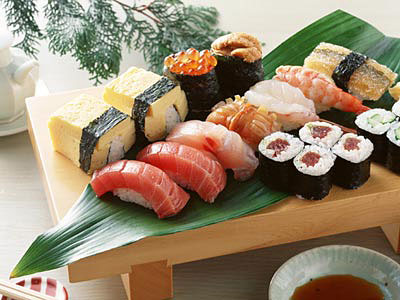From the archives, originally posted March 2, 2007. These delicately colored sushi are a great way to use __usuyaki tamago__. I know I've been re-posting things from the archives a lot lately, but I hope you'll forgive me - I'm moving tomorrow! In any case, I hope you'll give these delicate sushi a try, especially if you have daughters or granddaughters.

The 3rd of March is Momo no sekku or Peach Day in Japan. Peach blossoms usually start blooming around this time, signifying the coming of spring. It's also the day for _hina matsuri_, the Doll Festival or Girls' Festival. Households with daughters display hina ningyou-, traditional dolls that represent a princess's wedding procession. This is because the ultimate happiness expected for a girl was for her to make a fruitful and comfortable marriage. Nowadays girls may be expected to do other things besides become happy wives, but on this day at least traditions still hold strong.
In Japan there is a long standing stereotype that girls and women like very sweet things, while manly men like less sweet and bitter things. So, for Hina Matsuri the guests are served sweet things like amazake (a very thick non-alcoholic hot drink made from the lees of sake, rather like eggnog in color and cloying sweetness), hishimochi (tri-colored mochi cake) and okoshi (colored sweetened puffed rice). Although there were three girls in our house, none of us liked amazake at all. However, my mother often made some kind of sushi for Hina Matsuri, which we really loved.
Here are two kinds of very pretty, girlie sushi in feminine pink, yellow and white with a touch of green. These colors fit the theme of Hina Matsuri perfectly: the traditional hishimochi is colored white, pink (or light red) and green.
Filed under:
eggs japanese party food spring rice sushi bento
Submitted by maki on 17 February, 2009 - 20:40
Update: I've updated this post substantially in these two articles, 10 years later: How to cook great Japanese style rice, and How to make sushi rice (shari). Please take a look there - you'll probably find them a lot clearer. I've learned a lot myself in 10 years! ^_^
This is the first how-to and recipe that I posted on Just Hungry. Properly cooked rice is the foundation of a traditional Japanese meal, and you absolutely cannot skimp on the steps detailed here if you are aiming for anything approaching authenticity. I've edited the text to make some things clearer. Back to basics! Originally published in November 2003.

Rice is the staple of Japanese food, and making it just right can be rather difficult if you don't know how. If you think you will be preparing rice regularly, an electric rice cooker will make your life so much easier. You can cook non-Japanese style rice in it too, though I tend to make those in a regular pan.
Type:
recipe Filed under:
basics japanese rice sushi favorites
 This year, setsubun no hi (節分の日) falls on the 3rd of February (some years it's on the 4th). It marks the start of the spring season or risshun (立春) in Japan according to the old lunar calendar. It's not an official national holiday, but it is celebrated in ways all meant to drive away bad luck and bring in new, good luck. Most of the traditional rituals revolve around beans, because beans are considered to be very lucky. But there is another way of celebrating setsubun no hi, and that's with a big, long, uncut sushi roll called ehou-maki.
This year, setsubun no hi (節分の日) falls on the 3rd of February (some years it's on the 4th). It marks the start of the spring season or risshun (立春) in Japan according to the old lunar calendar. It's not an official national holiday, but it is celebrated in ways all meant to drive away bad luck and bring in new, good luck. Most of the traditional rituals revolve around beans, because beans are considered to be very lucky. But there is another way of celebrating setsubun no hi, and that's with a big, long, uncut sushi roll called ehou-maki.
I grew up in and around the Kanto region, which is the area around Tokyo, so I didn't know about ehou-maki ((恵方巻き)growing up, because it's a Kansai region (the area around Osaka and Kyoto) custom for setsubun no hi. Nowadays though the ehou-maki tradition has become popular nationwide. They are sold everywhere, especially at convenience stores, who take this as an opportunity to get people to celebrate, buy and eat in that awkward gap in between New Year's feasting and Valentine's Day chocolate gorging.
[Edit: ehou is pronounced eh-hoe by the way, not ee-h
aw.]
So, what makes an ehou-maki different from a regular sushi roll? There are basically three rules:
- It must contain seven ingredients, because seven is a lucky number.
- It must not be cut, because it might cut (off) your luck.
- You have to eat it while facing the lucky direction, which changes every year! This year's lucky directly is hinoe (丙 (ひのえ)), which is a little bit to the south of south-south-east on a regular compass. If you can read kanji, this page has a good chart.
- Finally, you must eat the whole roll in total silence.
A seven-ingredient sushi roll is basically a futomaki, or fat sushi roll, and that is what the directions are for. I've suggested several filling variations.

Last year, the Superbowl fell right on Setsubun no hi, so there's a New York-Boston filling combo below. This year, I guess the Cardinals were out of luck, ehou-maki wise. (What would have been a good Pittsburgh-themed sushi roll filling?)
You can of course order a regular futomaki from your favorite sushi takeout, and ask them to put in seven ingredients and to not cut it. Then on Sunday, face the right away, and solemnly eat your roll in total silence.
Filed under:
japanese party food sushi traditions
Today, three ocean conservation groups in the United States - the Blue Ocean Institute, the Environmental Defense Fund, and the Monterey Bay Aquarium - will each be releasing sushi fish selection guides. They all seem to be printed guides that you have to order (small quibbles: Why not a downloadable PDF so people can start using it immediately? Also, why 3 separate guides?) but if you are a sushi afficionado and are concerned about the sustainability of safety of the fish used as sushi neta, you may want to give one of them a look. See the press release here.
Filed under:
essays japanese sushi
Please forgive the lack of photos - in the middle of packing, I've somehow misplaced my camera. I'm sure it will come out soon, but in the meantime here is a handy tip for bring out the best flavor in wasabi powder.
Filed under:
japanese sushi
There were not one but two Op-Ed articles in the New York Times yesterday about sushi. Two! It always amazes me how fast sushi has become mainstream in the U.S. in particular and 'the West' in general, but I guess this is some sort of proof.
Filed under:
essays japanese sushi

While I've posted recipes for several different kinds of sushi on this site, I have never published a recipe for making nigiri zushi, the kind of sushi most people think of is the sushi, in spite of several requests to do so. There are a couple reasons for this, which you may want to consider before embarking on your own nigiri sushi making experiments. One reason, as I've written about before, is that it's quite difficult to get the nigiri part (the forming of the rice ball and placing of the neta or topping) right. Of course you can practice this, or use a sushi former, or even - if you get fanatical about it - a sushi robot. But the more serious reason is that raw fish is something to be very, very wary of at all times.
Filed under:
japanese sushi
Yesterday, I had some takeout sushi that was so terrible that I still shudder, more than 24 hours later, thinking about it.
No it didn't make me physically sick. I did not get food poisoning. But it was bloody awful. It was sold as 'fresh' sushi (and it certainly hadn't been frozen), but it had been refrigerated for some time, for who knows how long. (It had a 'sell-by date' but not a 'made-on date'. Sushi must, must, be eaten the same day it's made.) The rice was mealy, the grains hard. The neta (the fish) on the nigiri, salmon and tuna, was mushy and utterly tasteless. The rolls, filled with cucumber and some sort of tuna mix, were no better.
Filed under:
sushi ethics

I normally stay away from kaiten-zushi (kaiten sushi) or conveyor-belt sushi restaurants, since the quality can be iffy. But I could really go for this adorable miniature kaiten-zushi miniature set! (I'm not sure why the itamae-san (sushi chef) has Angelina Jolie lips though....) It's a new themed set from Re-Ment (US site) (Japanese site), a Japanese company that makes amazingly detailed die-cast miniatures called Puchi Petites, mostly of food and related items like cooking equipment, but of other things too. The miniatures started out as omake, or free gifts that came with the purchase of candy, but the miniatures have become so popular that the candy, while it's still included, is now a mere afterthought.
Filed under:
japanese sushi offbeat cute

Following up on the previous recipe for shell shaped sushi, here is another kind of sushi that's great for parties. Temari are small cloth balls made from leftover scraps of kimono fabric, and temari zushi are meant to look like these colorful toys.
You can make temari zushi with any number of things, such as thinly sliced sashimi grade fish, boiled and butterflied shrimp, thinly sliced and cooked or uncooked vegetables, and even thin slices of cheese. You will likely never see temari zushi at a sushi restaurant - this is homey home-style sushi.
For these, I've used thinly cut slices of pale pink smoked salmon, with tiny amount of cream cheese inside, rather in the same vein as a New York Roll - quite non-traditional but it's a great combination. The key is to make the temari zushi on the small side since they are quite rich.
Filed under:
japanese party food spring rice sushi fish bento
Pages